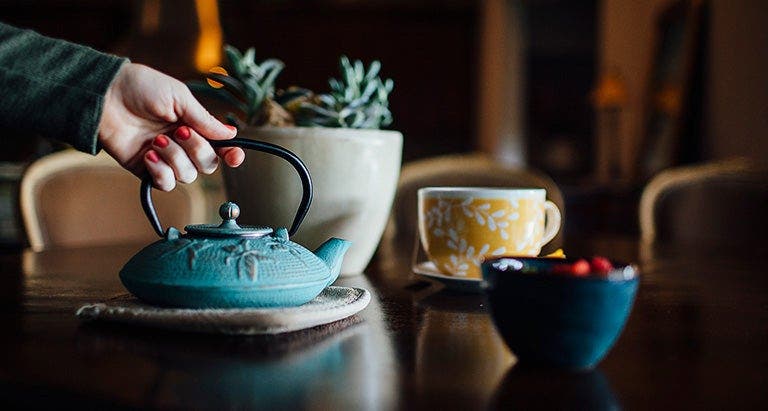Getting Cozy with Tea


"Better to be deprived of food for three days than tea for one." — Chinese proverb
With its subtle aroma, warm steam and soothing flavor, hot tea is an ideal treat—especially on a particularly blustery day.
"Tea is very nurturing," says Leslie Turner, a nutritional and holistic counselor in New York. "There's the whole ritual of tea, putting the water in the kettle, having it boil, pouring the tea, letting it steep. That in itself is very calming."
In addition to being emotionally comforting, studies have determined that black and green tea may have far-reaching medicinal properties. Green tea in particular is full of antioxidants, vitamins and minerals, including vitamin C, potassium and fluoride.
Although these discoveries are new to us, tea has been sipped for more than 5,000 years. Legend has it that tea was discovered in 2737 B.C. by Chinese emperor and herbalist Shen-Nung, when a leaf from a camellia bush landed in his pot of boiling water. Most tea is still made from that same plant species, Camellia sinensis. And its popularity has never waned: Tea is the second most consumed beverage in the world—second only to water, according to the Tea Association of the USA.
Now that there are more than 3,000 teas produced in 31 countries, deciding what to drink can be a challenge. Below is a guide to selecting, preparing and drinking this beverage.
So Many Teas, So Little Time
Black Teas are robust, with strong flavors and about half the caffeine of coffee. They may contribute to healthy arteries and prevent tooth decay. Examples: Earl Grey, Darjeeling, English Breakfast and Ceylon.
Oolong Teas are rich teas often served in Chinese restaurants. They're associated with good digestion and have slightly less caffeine than black tea. Examples: Shui Xian, Tie Guan Yin.
Green Teas have the most widely accepted health benefits and less caffeine than black and oolong tea. They're also full of antioxidants, vitamins and minerals and may help prevent certain cancers and osteoporosis as well as alleviate arthritis. Examples: Genmaicha, Kukicha, Hojicha.
White Tea The rarest type of tea, true white tea is found only in a specific area of China. It has the same health benefits as green tea, with minimal caffeine. Example: Pai Mu Tan.
Herbal Tea Not considered "true" tea by purists, these consist of herbs, spices and/or fruits. Turner recommends citrus teas for morning, peppermint for a mid-afternoon boost, a sweet tea for dessert and chamomile before bed.
"Trendy" Teas The "hot" teas of the moment: chai, a spicy Indian tea mixed with milk and sugar; bubble tea, a wild concoction made with tapioca pearls and flavorings like mango; and Rooibus, a popular South African tea that contains more antioxidants than green tea.
Teatime Tips
Basic guidelines for tea preparation:
- Use a steel or glass kettle.
- Fill with fresh, cold water.
- Let it reach a rolling boil, unless you're making green tea, in which case the water should be cooled for a minute or two after boiling.
- If you're making a whole pot, add a tea bag for each person plus "one for the pot."
- Never reheat tea; it gets bitter.
- Steep for about four minutes (a minute or two less for green tea).
- Taste before you sweeten. You may find that the tea is good as is. If not, try a tablespoon of honey.
As for counting tea as part of your daily water requirement, be aware that half of the amount of caffiene-free tea you drink can be counted, and tea with caffiene does not count. Turner also recommends checking with your doctor before embarking on any special tea regimen.
Tea drinking can soothe, perhaps heal, and sometimes help with weight loss-goals. "If you feel there are certain times during the day when you're vulnerable to emotional eating because you're stressed, drinking tea can help support you through that," says Turner.
